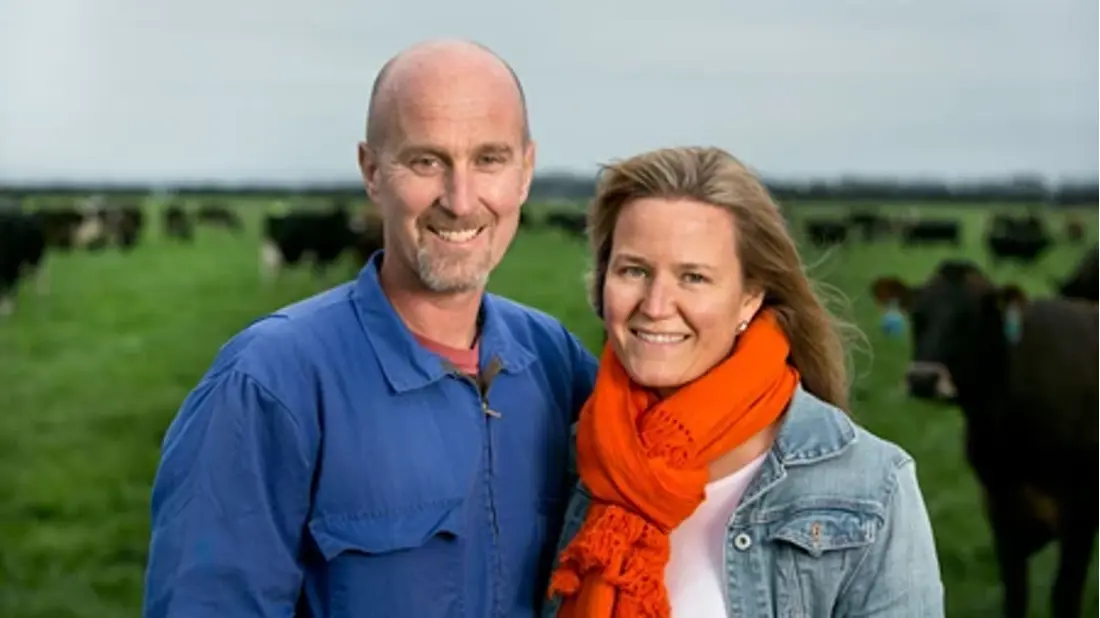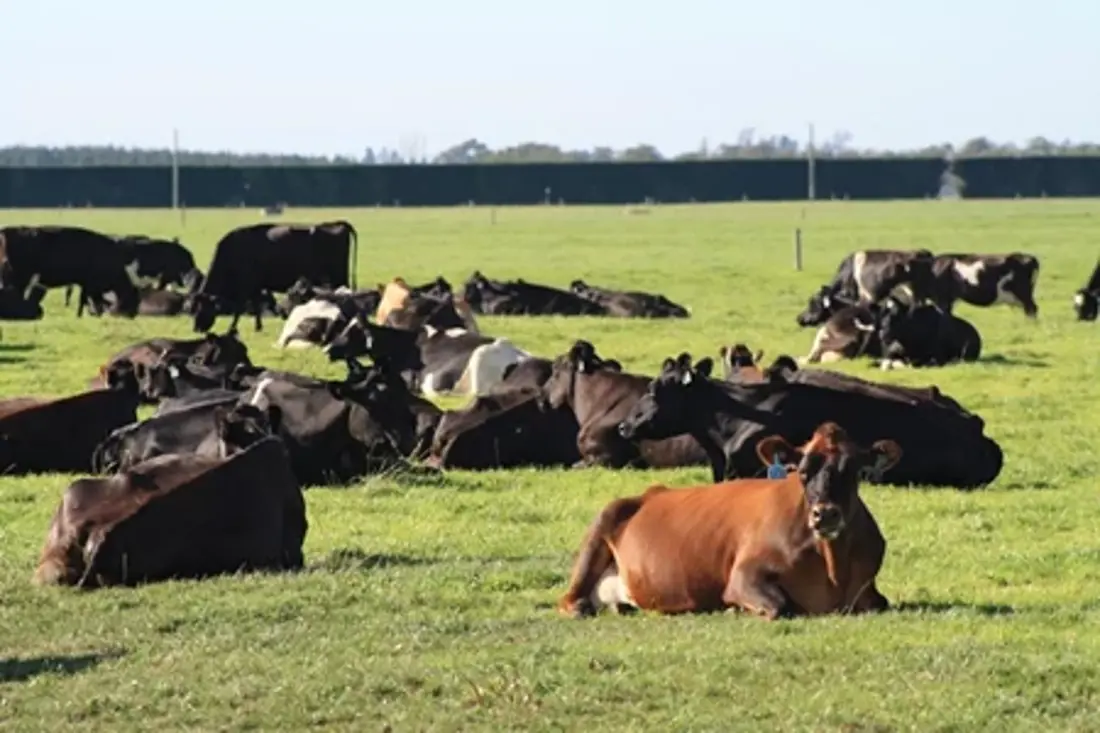Forages for Reduced Nitrate Leaching, Tony Coltman (Canterbury)
7 min read
Tony Coltman dairy farms near Dunsandel with a vision to lead in all areas of the dairy industry, including production, financial returns, environmental standards, and staff wellbeing. Since joining the FRNL programme, Tony has made various changes to his farm. He's grown more fodder beet, used more plantain in regrassing, and expanded the farm area. He's also reduced the use of imported supplements and decreased nitrogen fertiliser application, resulting in a significant reduction in nitrogen surplus and leaching. By participating in the programme, Tony aims to understand his farm's environmental impact better and contribute to sustainable farming solutions with real, practical data.
Tony Coltman dairy farms near Dunsandel. At the start of the programme the dairy farm had an effective milking platform area of 335 ha. This was 100% irrigated, at a stocking rate of 4.1 cows/ha. The farm also has a 155 ha leased support block providing winter grazing.
Since being involved in the FRNL programme, Tony has:

Tony Coltman and Dana Carver have a vision: “To be leaders in the dairy industry in all areas by excelling with top 5% production, top 5% financial returns, an aesthetically well-presented farm, all environmental standards exceeded, and happy and healthy staff.”
Despite now growing fodder beet on the platform, which can be associated with higher nitrogen (N) leaching losses than from pasture, other changes such as the decrease in N fertiliser use and decreased imported supplement, with associated lower stocking rate, have resulted in a reduction in purchased N surplus of 52% and a reduction in estimated N leaching of 36% since the start of the monitoring period.
Area:
335 ha effective milking platform
Area ( in 2018/19 season):
increased to 507 ha
Dominant soil:
Lismore silty loam, Mayfield silty loam
Average rainfall:
approx. 660 mm
Supplements fed:
2.2-3.9 t DM/ha
Cow numbers:
1367-2058 peak milked
Production:
1925-2147 kg MS/ha, 477-502 kg MS/cow
Support block:
155 ha leased
Pasture harvested:
17.8-18.6 t DM/ha
Trading:
Canlac Holdings 2014 Limited

To understand the environmental footprint of our business better and to contribute to the industry’s understanding of the whole environment issues at a practical farming level with REAL NUMBERS.
Because there are a lot of organisations and regulatory organisations out there wanting to change things and they don’t have all the facts or understanding of the implications for farming businesses and families. We don’t want to just stand around and complain about the issues and blame everyone. I wanted to contribute to finding a solution.
They will have REAL NUMBERS and PRACTICAL SOLUTIONS to the problems we are facing, and regularity organisations and industry will have some more factual information to base decisions on.
2015/16
Utilised feed pad, increased cow numbers and nitrogen (N) fertiliser, decreased supplementary feed imported and fed lifted fodder beet from support block on the milking platform in autumn.
A small amount of intensification occurred on farm in the 2015/16 season. Changes included:
This resulted in milk production increasing by 38 kg MS/ha, a slight decrease in the purchased N surplus, and a slight decrease in the amount of estimated N leaching.
This season was the first where the newly constructed feed pad could be utilised during spring and autumn. Fodder beet was lifted from a support block and transported back to the milking platform and fed on the pad during autumn. Utilisation was good from the feed pad and saved a lot of feed wastage.
2016/17
Growing fodder beet on the platform for autumn feed, reducing N fertiliser use, increasing imported supplement and continuing to establish plantain as part of a mixed sward.
This season had an increase in stocking rate and intensity, however with the use of low N feeds, less N fertiliser and increased milk production, purchased N surplus decreased by 19% and estimated N leaching decreased by 16% from 2015/16 levels.
This demonstrates that multiple changes drive improvements in environmental outcomes. The use of low N feeds (e.g. fodder beet, maize) and plantain increase the efficiency with which N can be used in the system, but simultaneously N inputs must decrease to capture the benefit of the greater efficiency.
System changes on Canlac during the 2016/17 season included:
Fodderbeet
During the 2016/17 season fodder beet was grown on the milking platform, which was used in autumn to extend the grazing rotation and begin transitioning in preparation for wintering on fodder beet.
Plantain
Tony established plantain on the milking platform for the first time as part of pasture renewal in two paddocks (25 ha, 7% of platform).
Plantain establishment trial
It will be difficult to achieve the levels of plantain needed to reduce N leaching across the farm through pasture renewal alone. A trial was run to investigate the cost-effectiveness of different methods of establishing plantain into existing pastures on Canlac and two other monitor farms.
Even though these percentages were low, on the other two monitor farms the treatments were sown in February and establishment was poorer still.
In the next season, plantain content had increased to approximately 20%. Other farmers notice this as well – expect the results to become visible in the next year.
2017/18
Decreased N fertiliser use and continuing to establish plantain as part of a mixed sward.
The farm system in 2017/18 was very similar to 2016/17. Changes include:
These changes decreased the purchased N surplus by 11% and the estimated N leaching by 13% compared with 2016/17 levels.
2018/19
Increased farm area, increased the area of fodder beet grown on the platform, winter milking, catch crop of oats grown, decreased stocking rate, decreased imported supplements and N fertiliser.
In general, 2018/19 was a good growing season. This year more land was integrated into the farm which increased the effective area from 335 ha to 507 ha. Other changes include:
This resulted in a 31% decrease in purchased N surplus and an 11% decrease in N leaching for 2018/19, compared with the 2017/18 season.
Tony Coltman
Tony Coltman: "We are continuing to refine what we do everyday. The large gain or low hanging fruit have been achieved, it is now small incremental gains. E.g. reduce N usage during summer months when clovers are more active for example. We might look at getting effluent to the whole farm. We are really looking to the industry now to help us find some technological things we can do to make more improvements."
Footnote: The potential effects on N leaching of the FRNL options implemented on the farm (plantain, fodder beet and catch crops) are not yet reflected in Overseer. FRNL researchers and Overseer are working together on updating the model and providing the necessary background information to users and other stakeholders, such as policy makers and regulators.
Canlac are continuing their contribution as partner farms in the Meeting a Sustainable Future project.
Now’s the perfect time to check in, plan, and set up for a strong season. We’ve pulled together smart tips and tools to help you stay ahead all winter long.
Whether you prefer to read, listen, or download handy guides, we’ve got you covered with trusted tools to support your journey every step of the way.
Put our proven strategies and seasonal tools to work. Boost production, support animal health and watch your profits hum.
Tools that are backed by science, shaped by farmers and made for this season.
That’s Summer Smarts.